From a dull knife to a shaving edge in less then a minute!
In 2 Easy Steps (Dry Hone, Oil Hone)
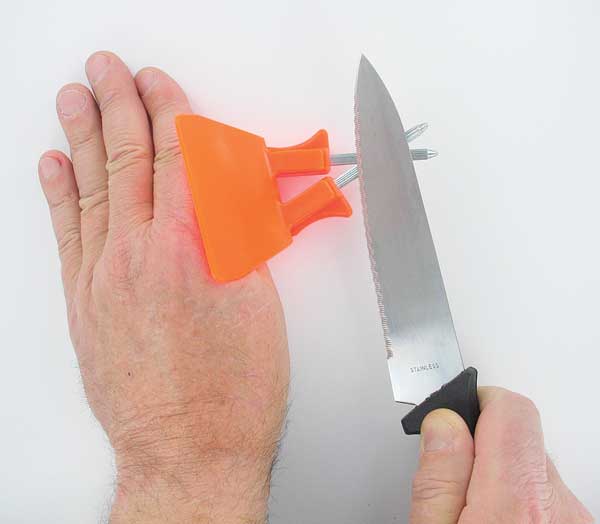
Dull Knife Preparation – A
Major flat spots:
Use the top rod like a file and create a rough edge. Locate the relief on the blade (which is the visible bevel) then stroke from the heal to the tip on both sides of the knife, removing all the nicks, burrs or flat spots, creating a rough edge, but not a finished edge. On serrated knives rough up the flat side only and do not use the coin below.
Remember: If this doesn’t break the edge, unfortunately you will need a grinder to re-edge your knife.
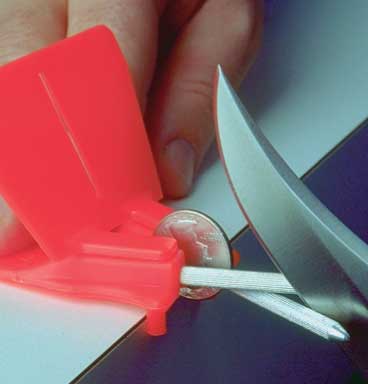
Dull Knife Preparation – B
Place a coin (nickel or quarter) behind the rods on straight edges only:
Pictured to the left, insert the coin and place it behind the rods and edge of counter. Using a firm stroke, draw the blade from the heal to the tip of the knife, until the stroking hand holding the knife runs smooth and quiet with no resistance from the blade.
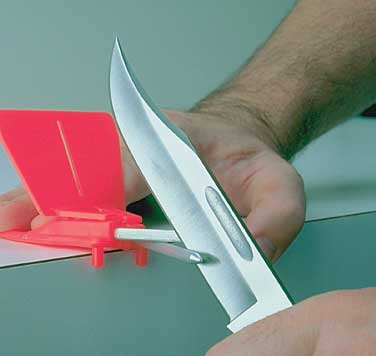
Step 1 – Dry honing the blade. Simply place your thumb behind the back of the knife and stroke the rods dead center until sharp. This sets your edge, making it capable of cutting meats, vegetables, paper or anything you want to cut. It is just not shaving sharp yet. This is a good utility edge for many cutting chores. You will want to proceed to Step 2, Oil honing if you want your knife sharper.
Step 2 – Oil honing your blade to the final edge. Repeat as in step 1, but this time run a bead of oil on the edge of the blade. Lightly stroke the rods dead center for a polished shaving edge. However, if your knife has cheap steel you may not get a very sharp edge. Remember, the better the steel the better the edge.
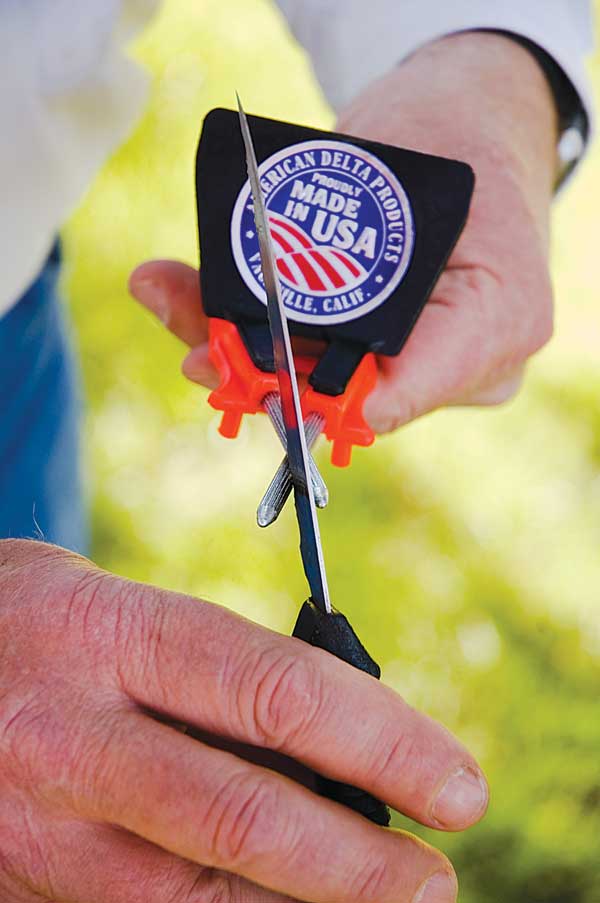
Special Sharpening Instructions for Serrated knives.
When sharpening Spyderco® type edges, lay the flat side of the knife against one rod, the other rod will vibrate sharpening the peeks and valleys. Use Dull Knife Preparation – A on the flat side only, not the beveled side, to remove any nicks, burrs, or flat spots. The same is true when sharpening Benchmade® type knives straight or serrated. Some knives have a straight edge in the front half and half bevel serrated edge at the rear of the knife. In this case sharpen as though you have two knives in one.
Note: When using serrated knives put the flat side against one rod and gently stroke, vibrating the other rod. Using very light strokes, the vibration sharpens twice as fast as a straight edge blade. DO NOT USE COIN
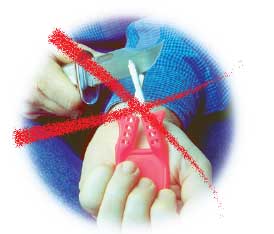
IMPORTANT
Always use the hand-guard supplied with your product. Never use this product while holding it in your hand. To operate this product always it lay down on a flat surface, or stand up the handle, with the rods pointed down, inserting the blade in the center opening between the handle and rods. Sharpening knives is dangerous. When using this product or any other sharpening device, always use extreme caution. By accepting this product, you assume full responsibility and risk of sharpening.
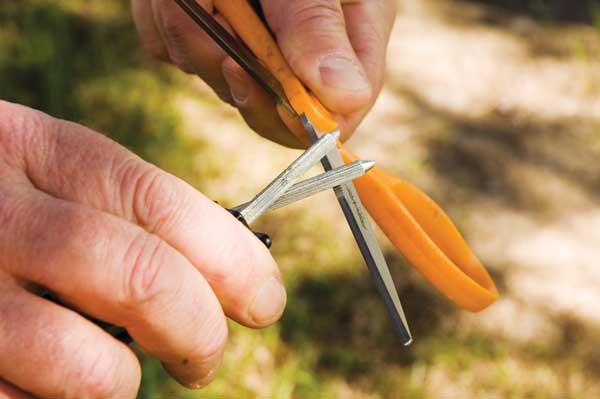
SCISSORS
Scissors have a sloping beveled edge, the degree of which varies. Simply place the sloping edge on the top rod, and ride it from the inside of the blade to the tip. Use 4 to 5 light strokes on both blades, one blade at a time. If you have an adjustment screw, you may want to tighten or loosen the two blades as needed, sloping edge for best results. It is not recommended that you use these methods on expensive haircutting scissors.
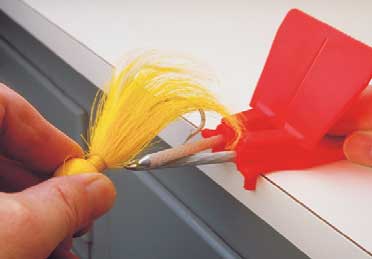
FISHHOOKS
Notice the grooves on the nitride rods, called nurrelling, or nurreled lines. Place your fishing hook tip inside one of these nurreled lines on the top rod. Glide the hook tip back and forth inside the nurrel to restore the tips sharpness and puncture power. The rods are specially plated to hold up against salt water exposure and corrosion.
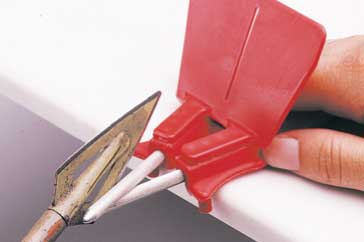
ARROWHEADS — Use STEP 1
To hone a final edge on those broad heads, simply leave the arrowhead on the shaft and stroke between the nitride rods as you would a knife blade. Oil the rods and repeat the procedure with light strokes. (Sharpening a 4 blade arrow may be difficult, so remove 2 blades and sharpen 2 blades at a time as shown in the picture.)
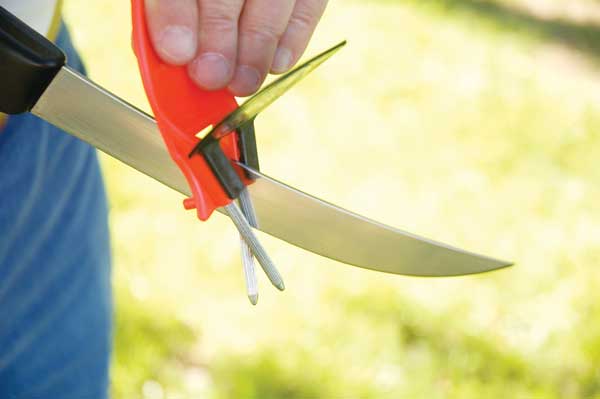
For a Quick Touch-UP
For a quick touch up when a flat surface in not available, place the rods pointed down on a sturdy surface, insert the blade in the center opening between the handle and the rods (as shown in adjacent picture) and draw the blade through 10-15 times. As the angle is the same on the inside as well as the outside of the rods, you are only limited by the width of your blade. For large blades such as butcher knives, machetes, hatchets, etc., use step 1.